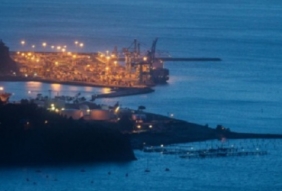
Posted on June 23, 2016
By Charlie Mitchell, stuff
Lyttelton Port of Christchurch has announced plans for New Zealand’s largest dredging project, which will allow it to accept larger ships.
Lyttelton Port will dump sediment across an area seven times the size of Christchurch’s Hagley Park, in what it says will be New Zealand’s largest dredging project.
It is part of the port’s ambitious 30-year vision, in which it will spend $1 billion on re-development.
Lyttelton Port of Christchurch (LPC) will soon seek permission to expand and deepen the Lyttelton harbour channel, allowing larger ships to enter the port.
It wants to extend the channel by 6.5 kilometres, doubling its current length. It will also make it 20 metres wider and up to 6m deeper.
The dredging plan proposed by Lyttelton Port of Christchurch. The rectangle to the right is where sediment will be dropped.
The project is triple the size of CentrePort’s dredging plan in Wellington.
LPC said it expected to spend $80 million to $120m on the dredging project.
It said container ships were getting bigger, and increasing the depth of the channel would allow the port to remain internationally competitive.
The largest ships at the port had capacity for up to 5000 containers. With a deeper channel, it could take ships carrying up to 8000 containers.
“The dredging proposal is future-proofing our port,” LPC chief executive Peter Davie said.
“We need to have the right facilities and capacities to continue to attract major international shipping lines.”
If the project was approved, the port would run a dredger 24 hours a day, seven days a week for about a year.
It would suck up 18-million cubic metres of sediment from the harbour – enough to fill three million concrete trucks – and dump it in a “disposal zone” about five kilometres off Godley Head.
The 12.5 square km zone is about seven times the size of Hagley Park.
Sediment will pile nearly a metre deep on the seabed, covering the entire zone.
The port has committed to minimising environmental effects and has spent $3 million preparing for the resource consent, which includes work with a range of scientists and commissioning research into the environmental impacts.
There would be temporary disruptions to seabed ecology and marine life in the dredging area, but they would re-establish once work was finished, the port said.
Extensive monitoring from 15 stations would give real-time data about water quality.
“The environmental monitoring programme we put in place will be the most extensive ever undertaken on a dredge project in New Zealand and we are working alongside leading international organisations that have significant expertise in this area,” Davie said.
The port would apply for resource consent from Environment Canterbury in September, and would ask for the consent to be notified so the public could make submissions.
The consenting process would likely take about a year, with work expected to begin in late 2017.
Despite reservations about some of the port’s broader plans, Lyttelton-Mt Herbert Community Board chairwoman Paula Smith said the dredging proposal had not immediately raised concern.
“The community board has quite a pragmatic view – we accept that it probably has to happen for the port to remain competitive.
“Our goal will be to make sure it is done in the best possible way.”
She said the port had ideas about how to reduce environmental effects, and the consent process – which included the potential for an appeal to the Environment Court – would allow for any problems to be addressed.
“I hope that by doing this they’re [LPC] not going to create some new issues, but I expect their science will demonstrate that they’re not, and it will be for the process to work out whether their science is good enough.”
If approved, the project could be completed in 2019.
The LPC is holding a drop-in session about its plans at its Port Talk building in Lyttelton on Saturday.
Source: stuff





